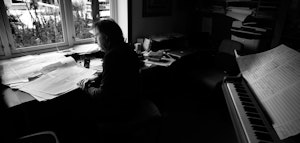The Aural Sonology Project has opened a novel approach to musical analysis. It is now possible to analyse music in a systematic way by ear, using a recording (‘phonogram’) of the music as reference, rather than on a score. The approach is particularly useful in dealing with music for which no score is available (e.g. electro-acoustic music) or music with no simple one-to-one correspondence between score and the aural phenomenon (which is often the case with late romantic and impressionist music as well as contemporary music).
Nevertheless music in which such a correspondence is evident (e.g. classical Western music) is by can also be analysed with this method, as long as the piece is represented on a phonogram and analysed on the basis of it.
In order to achieve a systematic analytical approach with a degree of inter-subjective consensus, the analytical methods are backed up by a theory of listening intentions. The focus of the analytical methods is partly the categorisation of single sounds (sound-objects), partly form-building relationships.
More features
The above features make the methods of analysis particularly up-to date in the age of multi-media technology, when the importance of the written document as the sole repository of a musical work, is dwindling. Another essential feature is the generality of the methods: they can be applied to music in a number of different styles; this facilitates the transfer of musical experiences from one stylistic context to another (e.g. from classical to contemporary music).
While the methods show no particular stylistic preference, they are nevertheless dependent on an aesthetical context in which organic form principles are in dominance (i.e. forms in which constituent parts are assigned a limited number of functions among themselves and the whole). Music in which such organic forms can be observed by the ear, is supposed to be easier to comprehend than music lacking such properties.
What can this method offer?
The method offers a systematic way for the student to expand and articulate his conscience of sonorous forms and form-building patterns. The focus of the methods is on gestalt-related patterns that are evident from listening to the music itself. Musical forms that have evaded the classical schemata emerge and become comprehensible through the process of analysis. For the student of composition, the conductor, and the interpreter this offers valuable in-depth insight into the possibilities of shaping the music in a concise way.
To the student of musicology and analysis the method offers a set of predefined analytical terms. The definition of the analytical terms is founded in the combination of explicitly described listening intentions, and sonorous musical examples.
Through an adaptation of Schaeffer’s system for describing sound objects, sound-qualities that earlier could only be hinted at through the use of vague adjectives ( ‘bell-like’, ‘sharp’, ‘grunts’ ‘squeaky’) can be described with neutral concepts that are structurally correlated; they can also be notated and integrated in a written paper, as is normally done with score examples.
Moreover, form-building features – phrase-structures, constellations of fore-ground and background, dynamic forms, patterns resulting from variations of structural intensity - can be identified and described, graphically and verbally.
Aural Sonology offers methods of analysing
- Spectromorphology (types of musical sound)
- Characters and values in Sound-based music
Form-building features such as:
- Time-fields (successive segmentation)
- Layers and their functions (synchronous segmentation)
- Dynamic Forms (over all tendency, accent functions)
- Form-building Processes (recurrence, variation, contrast, similarity)
- Form-building Transformations (constellations of complex and simple, line vs. texture, characteristic vs. anonymous)
A method of semiotic analysis of music-as-heard offers consistent tools for the discussion of musical signification, in a way that explicates the listener’s own perspective of creating meaning out of sound (‘semiosis’) as an integral part of stating his conclusions. This provides a basis for meaningful discussions of musical signification.
The aural sonology project also discusses a number of theoretical issues relating to foundational musical problems.
Emergent Musical Forms
Emergent Musical Forms. Aural Exploration is a book on the subject of Aural Analysis published in Vol. 24 of Studies in Music of the University of Western Ontario. The book is accompanied by a web page, in which the many musical analyses occurring as figures throughout the book, are presented in synchrony with the music they analyse. See the Aural Sonology website here.
In this way, the reader/listener will be helped in creating the connection between on the one hand the music as heard, and on the other, the many new signs and concepts. The analysis are presented with the Acousmograph, a digital tool developed by INA/GRM.
A special plug-in of the Aural Sonology has been developed as part of the Aural Sonology Project, so that a student wanting to use the graphical signs developed through the project, will have a practical way to present her analysis. A free down load of the program (Acousmographe 2.7) can be freely downloaded from the web page of INA/GRM. In addition, special fonts used to draw the analysis in a Word document, are available.
Published papers
Thoresen, L. 1985a. Auditive Analysis of Musical Structures. In A Summary of Analytical Terms, Graphical Signs and Definitions. Proceedings from the ICEM Conference on Electroacoustic Music. Stockholm, Sweden, 25–27 September.
Thoresen, L. 1985b. Un model d’analyse auditive. Analyse Musicale 1: 44–59.
Thoresen, L. 1986. Ornamentet som strukturens motpol. Kunsthåndverk 21: 5–10.
Thoresen, L. 1987. An Auditive Analysis of Schubert’s Piano Sonata Op. 42. Semiotica, 66(1–3): 211–37.
Thoresen, L. 1996. Flerskiktighet i Olav Anton Thommessens orkestermusikk. In Olav Anton Thommessen, Inspirator, Tradisjonsbærer, Rabulist. Oslo. Norsk Musikforlag, 153–77..
Thoresen, L. 2007a. Form-building Transformations: An Approach to the Aural Analysis of Emergent Musical
Forms. Journal of Music and Meaning 4; section 3. http://www.musicandmeaning.net.
Thoresen, L. 2007b. With the assistance of Andreas Hedman. Spectromorphological Analysis of Sound-Objects: An Adaptation of Pierre Schaeffer’s Typomorphology. Organised Sound, 12(2): 129–41.
Thoresen, L. 2009. With the assistance of Andreas Hedman. Sound-Objects and Form-Building Gestalts in Åke Parmerud’s ‘Les objets obscurs’. Organised Sound, 14(3): 310–20.
Thoresen, L. 2010. With the assistance of Andreas Hedman. Form-Building Gestalts and Metaphorical Meaning. Organised Sound, 15(2): 82–95.
Thoresen, L. 2012. Exosemantic Analysis of Music-as-Heard. Proceedings of the Electroacoustic Music Studies Conference Meaning and Meaningfulness in Electroacoustic Music.. Stockholm, June 2012. http://www.ems-network.org
Financed by
- Norges musikkhøgskole
- Lindemans Legat
- INA/GRM
- Norsk faglitterær forfatter- og oversetterforening
- Norges allmennvitenskapelige forskningsråd

